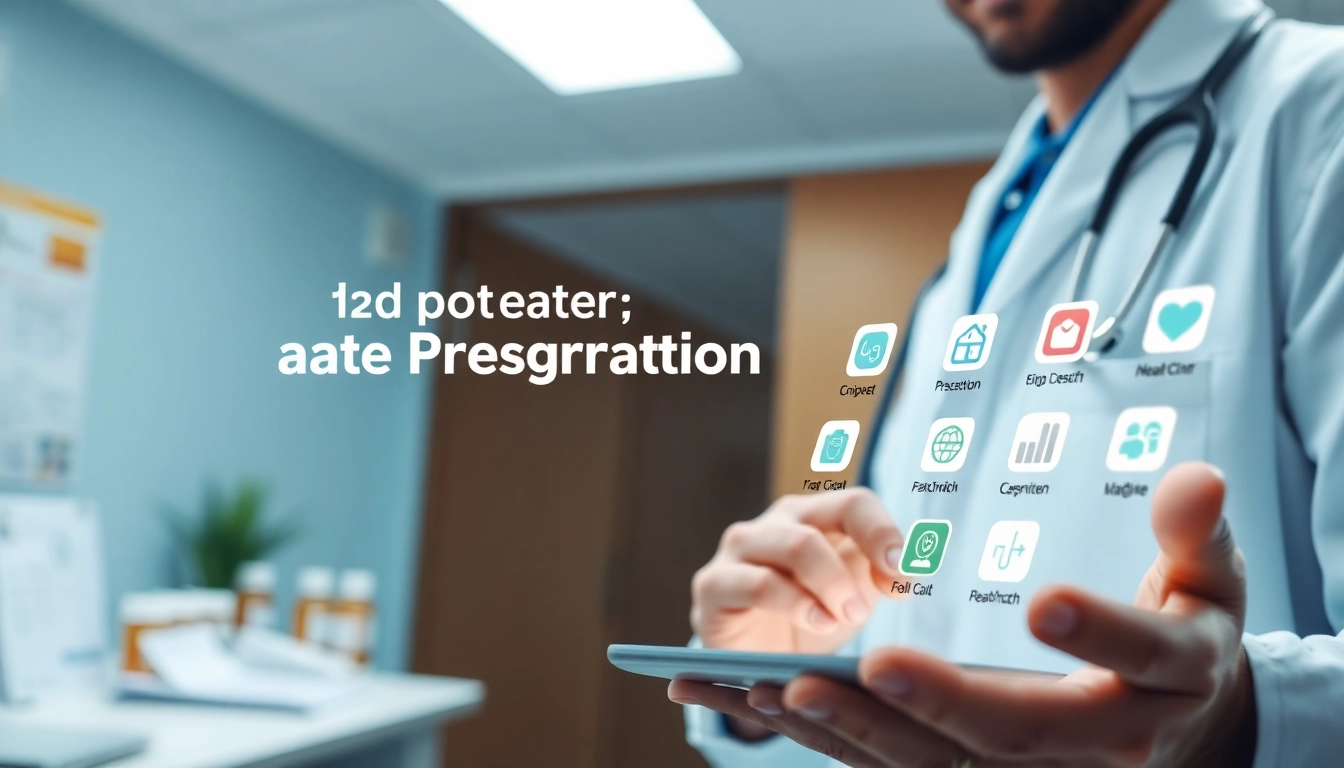Understanding the Importance of Top Rated Prescription Applications
Advancements in technology have transformed countless facets of healthcare, and prescription management is no exception. The rise of top rated prescription applications has empowered clinicians and patients alike, streamlining the prescription process while enhancing overall healthcare delivery. This article delves into the multifaceted benefits of utilizing these applications, the essential features to seek out, and how they significantly improve patient outcomes.
1. Benefits of Using Prescription Applications
Prescription applications bring numerous benefits that enhance both the efficiency of healthcare providers and the patient experience. These advantages include:
- Improved Efficiency: Prescription applications reduce paperwork and eliminate errors often associated with hand-written prescriptions. Clinicians can quickly send prescriptions electronically, minimizing the time spent on administrative tasks.
- Enhanced Patient Engagement: Many applications provide patients with reminders for medication refills and doses, fostering greater adherence to their treatment plans.
- Access to Information: Clinicians can access vast databases of medication information, including potential interactions and side effects, promoting safer prescribing.
- Streamlined Communication: Direct messaging features allow for clarifications and adjustments without the back-and-forth of phone calls or face-to-face meetings.
- Cost Efficiency: Prescription comparison tools embedded within applications help patients find affordable options, ultimately leading to reduced out-of-pocket expenses.
2. Key Features to Look For
When selecting a prescription application, the inclusion of essential features is critical for maximizing benefits. Key features to consider include:
- Intuitive User Interface: A user-friendly design ensures that both healthcare providers and patients can navigate the application with ease.
- Electronic Prescription Capabilities: Look for applications that enable e-prescribing to simplify the prescription process for both the prescriber and the pharmacy.
- Medication Reminders: Features that send reminders for medication doses help improve adherence rates among patients.
- Access to Patient Medication History: Applications should allow clinicians to view patients’ medication histories to avoid potential drug interactions.
- Integration with Electronic Medical Records (EMRs): Compatibility with existing EMR systems can facilitate smoother workflows.
3. How These Applications Improve Patient Outcomes
The incorporation of top rated prescription applications in healthcare settings has been linked to significant improvements in patient outcomes. Several studies illustrate these benefits:
- Adherence to Treatment: By sending reminders and alerts, these applications play a crucial role in helping patients follow their prescribed treatment plans.
- Reduction in Medication Errors: Electronic prescriptions reduce misunderstandings or mistakes related to handwritten notes, leading to safer prescribing.
- Increased Patient Knowledge: Many applications include educational resources that empower patients to better understand their medications.
- Timely Adjustments: Clinicians can quickly adjust prescriptions in response to patient feedback, facilitating a more personalized treatment approach.
Top Rated Prescription Applications for Professionals
1. Applications for Prescription Management
Several applications stand out for their prescription management capabilities, each offering unique features tailored to specific needs. Professionals should evaluate applications based on their specific use case, taking into account aspects such as provider-patient communication, prescription accuracy, and the ability to manage multiple prescriptions simultaneously.
2. Telehealth Integration in Prescription Apps
Telehealth has emerged as an invaluable tool, especially in the wake of recent global health challenges. Integrating telehealth features into prescription applications enhances accessibility for patients. Key benefits include:
- Convenient Consultations: Patients can consult with their healthcare providers through video or chat, leading to timely and efficient medical advice.
- Immediate Prescription Updates: Healthcare providers can alter prescriptions during consultations, sending updates directly to pharmacies within minutes.
- Wider Reach: Telehealth functionalities enable healthcare access to patients in remote or underserved areas.
3. User-Friendly Interfaces and Accessibility
The success of a prescription application heavily relies on its interface and accessibility. Applications should cater to a diverse patient demographic, ensuring the following aspects:
- Multi-Device Synchronization: Patients often use various devices. Applications should be accessible on smartphones, tablets, and desktops, with seamless integration.
- Accessibility Features: Voice commands and text-to-speech functionalities can aid individuals with disabilities in using these applications effectively.
- Language Options: Multilingual support ensures that non-English-speaking patients have equal access to their prescriptions and related information.
Evaluating the Best Options for Your Practice
1. Criteria for Evaluation
When evaluating prescription applications, healthcare professionals should consider several criteria to ensure the selected application meets their needs efficiently:
- Compliance with Regulations: Applications must adhere to healthcare regulations, including patient privacy laws.
- Customization Options: The ability to tailor the application to fit specific workflows enhances user satisfaction.
- Support Services: Ongoing technical support and troubleshooting options are vital for seamless usage.
2. Comparing User Ratings and Reviews
Reviews and testimonials can provide valuable insights into the efficacy and reliability of prescription applications. Healthcare providers should:
- Analyze Reviews: Assess user ratings on trusted review platforms to gauge overall user satisfaction.
- Seek Case Studies: Look for documented evidence of successful implementations to understand practical outcomes.
- Engage with User Communities: Participating in forums can offer firsthand experiences from peers who currently utilize similar applications.
3. Case Studies of Successful Implementations
Real-world case studies can offer insights into how prescription applications have enhanced practice management and patient outcomes. Healthcare professionals should focus on:
- Quantitative Improvements: Measure improvements in workflow efficiency and patient adherence rates.
- Qualitative Feedback: Collect feedback from staff and patients regarding their experiences with the application.
- Longitudinal Insights: Evaluate how the application impacts patient care over time, looking for sustained benefits.
Trends and Innovations in Prescription Application Technology
1. Emerging Technologies in Healthcare Apps
As the landscape of healthcare technology evolves, prescription applications are increasingly incorporating cutting-edge innovations. Some notable trends include:
- Blockchain Technology: Enhanced security for patient data through decentralized records may revolutionize prescription management.
- Wearable Device Integration: Connectivity with wearables allows real-time monitoring of patient health metrics related to medications.
- Drones for Delivery: Streamlining the delivery process, drones can ensure timely receipt of prescriptions, especially in hard-to-reach areas.
2. Impact of Artificial Intelligence
The integration of artificial intelligence (AI) in prescription applications presents numerous opportunities to optimize healthcare practices:
- Predictive Analytics: AI can analyze patient data to predict adherence patterns and suggest interventions when non-compliance is likely.
- Personalized Medicine: AI algorithms can provide tailored medication recommendations based on individual patient profiles.
- Natural Language Processing: Advanced communication features can facilitate effective interactions between patients and healthcare providers.
3. Future of Mobile Health Solutions
The future of mobile health solutions appears promising, with anticipated advancements in prescription applications. Expectations include:
- Greater Connectivity: Enhanced capabilities for integrating healthcare systems and enabling better communication between stakeholders.
- Broader Adoption: As regulatory barriers lower, more healthcare entities will adopt these applications, further enhancing patient care.
- Continuous Learning: An emphasis on machine learning will enable applications to improve over time based on data gathered thus providing enhanced clinical insights.
Implementing Top Rated Prescription Applications in Your Workflow
1. Steps for Smooth Integration
Successfully implementing a prescription application into your practice requires systematic planning and execution:
- Conduct a Needs Assessment: Evaluate your existing workflows to identify areas that require enhancement through technology.
- Define Clear Objectives: Set specific goals for what you want to achieve with the new application, such as improving patient adherence or efficiency.
- Choose an Implementation Team: Assemble a diverse team that represents different areas of the practice to ensure all perspectives are considered.
2. Training Staff on New Applications
Training is fundamental to the successful adoption of new technology in healthcare settings. Consider the following approaches:
- Interactive Workshops: Hands-on training sessions allow staff members to familiarize themselves with the application and its functionalities.
- Resource Availability: Create easy-to-access guides and FAQs to assist staff in navigating the application post-training.
- Ongoing Support: Designate tech-savvy staff as go-to resources for questions or troubleshooting during the transition period.
3. Measuring Success and Outcomes
After implementation, it is vital to assess the impact of the prescription application on practice performance. Key strategies include:
- Setting Key Performance Indicators (KPIs): Identify measurable outcomes, such as adherence rates and prescription error reductions, to track improvements.
- Regular Feedback Loops: Regularly collect both staff and patient feedback to adjust workflows and address any challenges that arise.
- Periodic Review Meetings: Schedule regular check-ins with the team to discuss the progress and hurdles faced in using the application.



